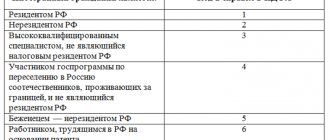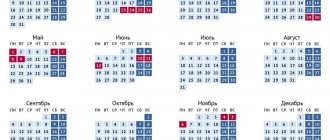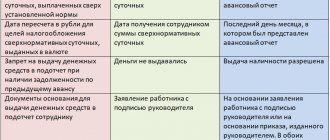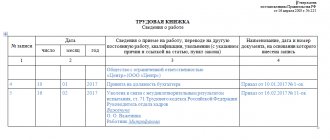Choosing the optimal tax regime
When a citizen registers as an individual entrepreneur, he must choose a tax regime. Each of them has its own pros and cons, as well as criteria for its application (especially in relation to special modes).
Starting from 2021, individual entrepreneurs can apply the following tax regimes:
- professional income tax;
- patent tax system;
- simplified taxation system;
- single agricultural tax;
- general taxation system.
In 2021, entrepreneurs could also apply the single tax on imputed income (UTI), but from 2021 this special regime is canceled, so in the article we will not talk about UTII for individual entrepreneurs. But I would like to draw attention to the fact that PSN is considered a regime designed to replace UTII.
Each special mode has its own limitations
by income level, possible types of activity, number of employees and cost of fixed assets. We will talk in more detail about each of the tax regimes below.
Some entrepreneurs, in addition to the main criteria, also pay attention to the obligation to submit reports and keep records. In general, on the basis of Federal Law No. 402-FZ dated December 6, 2011 “On Accounting,” individual entrepreneurs are not required to maintain financial statements. However, individual entrepreneurs must keep tax records and are also required to submit reports. Each tax regime has its own reporting, as well as its own reporting deadlines and frequency of submission (from once a month to once a year). Therefore, if an entrepreneur plans to run a small business, submitting reports every month will be problematic for him - especially if he does not have an accountant.
The Federal Tax Service has developed
a special calculator that online helps individual entrepreneurs decide on the optimal tax regime.
When working with the calculator, you should select:
- category “individual entrepreneur”;
- expected level of income for the year;
- number of employees.
Depending on the selected indicators , the online calculator suggests which taxation regime is best for individual entrepreneurs
.
For example, an entrepreneur plans to receive 1.5 million rubles in income in a year and employ up to 5 people. At the same time, he does not want to keep tax records and submit reports. We indicate the selected criteria in the calculator.
With such “wishes” there is no taxation regime for individual entrepreneurs. If we remove the absence of the obligation to keep tax records, then the entrepreneur is advised to consider the patent tax system.
However, please note that this calculator only selects tax regimes based on the basic criteria specified. But besides them, there are also additional parameters. For example, specific types of activities are established for the application of PSN. If an entrepreneur is engaged in a type of activity “prohibited” for a patent, for example, the production or sale of excisable goods, it is natural that he will not be able to apply such a special regime.
All these nuances are not available in the online calculator. Therefore, even when using a calculator, it is worth studying the tax regime in more detail
, which are planned to be selected.
In addition, on the Federal Tax Service website there is
a special comparative table indicating all tax regimes, tax rates, tax base, reporting period and reporting.
How to get back an overpayment if you have already paid for a patent
If the patent has already been paid for, you must first submit a notification according to the procedure described above. Then act as if you had overpaid taxes normally— apply for a credit or refund .
For example, an entrepreneur bought a patent for January-March 2021 in order to determine during these months whether the patent system is suitable for him. He must pay the cost of the patent no later than March 31, 2021. He has not yet paid the fees in January, but he has managed to list the cost of the patent.
In February, the individual entrepreneur transferred the fees and decided to return the overpayment for the patent.
To do this, he must submit a notification of a decrease in the value of the patent to the tax office, and then write a statement:
- or to offset the overpayment against the cost of the second patent, if after the first he decides to buy another patent;
- or to return the overpayment to the current account if he decides not to buy a patent again this year. You can only return the amount paid for the patent.
If possible, do not rush to pay for the patent before you have paid the fees and submitted a notification, so as not to bother with the return of the overpayment.
NAP for entrepreneurs
NPA is a tax on professional income
. It can only be used by those entrepreneurs who earn money with their own labor, that is, the self-employed. It is important to know that NAPs can be applied not only by individual entrepreneurs registered with the tax office, but also by ordinary people - without registering an individual entrepreneur.
Self-employed people are prohibited from:
- resell goods (except personal items);
- engage in the extraction and sale of minerals;
- sell or manufacture excisable goods;
- conduct mediation activities;
- engage in the delivery of goods with the acceptance of payments in favor of the sender (with the exception of accepting payments through the sender’s cash register system).
In addition, an entrepreneur who is considering the possibility of applying NAP should not hire anyone, and, therefore, he does not have the right to use hired labor in his work (with the exception of help from relatives without paying them wages).
Another main criterion for applying this special regime is that the annual amount of self-employment income should not exceed 2
.
4 million rubles
.
An individual entrepreneur applying NAP is exempt from paying the following types of tax:
- personal income tax;
- VAT;
- fixed insurance premiums.
Please note that if an individual entrepreneur fails to comply with the NAP, he will have to pay personal income tax to the budget and choose a different taxation regime
.
The professional income tax has two rates
:
- 4% – when receiving payment from individuals;
- 6% – when receiving payment from individual entrepreneurs or organizations.
The tax amount is calculated by the tax authorities
. Notification of payment of NAP is sent to the self-employed no later than the 12th day of the month following the end. It indicates the amount of NAP and details for payment. The tax is paid monthly, no later than the 25th day of the month following the reporting month.
In addition, individual entrepreneurs do not submit any reporting forms to the tax authorities on NPD.
You can read more about the tax on professional income on the Federal Tax Service website at this link.
Example: An individual entrepreneur produces confectionery products. He works without hiring employees and is registered with the Federal Tax Service as self-employed. In 2020, his income amounted to 1 million rubles, of which 700 thousand rubles were profits from individuals, and orders for legal entities amounted to 300 thousand rubles.
In total, for 2021, an individual entrepreneur must pay 46 thousand rubles to the budget for NPD (28 thousand rubles for income from individuals (700,000 rubles * 4%) and 18 thousand rubles from income received from legal entities (300,000 rubles * 6 %)).
How to fill out a notification
The recommended form of notification, format and procedure for submission were approved by letter of the Federal Tax Service dated January 26, 2021 No. SD-4-3/ [email protected]
The notice consists of three parts:
- title page;
- sheet A;
- sheet B.
On all sheets you must indicate the entrepreneur’s TIN and page number. We will consider the specifics of filling out the remaining details separately for each part.
On the title page please indicate:
- code of the tax office where the patent was purchased (the first four digits of the patent number);
- full last name, first name and patronymic (if any) of the individual entrepreneur;
- the number “1” if the notification is signed personally by the individual entrepreneur, or the number “2” if an authorized person. In this case, do not forget to indicate the name of the authorized person, the date and number of the power of attorney, attach a copy of it and note the number of sheets of the copy of the power of attorney.
Then you need to provide a telephone number for contact, sign and date. After filling out sheets A and B, all that remains is to enter their quantity on the title page (field “This notice was drawn up on...”).
On Sheet A, indicate information about the patents for which you want to reduce the value.
Here we indicate:
- line 010 - patent number (indicated on the title page of the patent);
- line 020 - the date of its issue (indicated to the right of the number on the title page of the patent);
- line 030 - tax amount, i.e. the cost of the patent (indicated on the back of the patent in the table using line code 040).
On sheet B, indicate the total amount of paid fees and benefits by which you want to reduce the cost of the patent.
In particular:
- line 001 - “1”, if you pay individuals (under employment contracts, under civil servants’ agreements), “2” - if there are no such payments;
- line 110 - the total amount of tax that you plan to reduce (sum up the values of lines 030 of sheet A);
- line 120 - the amount of insurance premiums and benefits by which we reduce the cost of the patent.
PSN for individual entrepreneurs
The patent taxation system is designed specifically for individual entrepreneurs. Individual entrepreneurs can switch to this special regime only upon application. The patent term ranges from 1 month to 1 year
, after which the entrepreneur can file another application for the use of a patent for a period of up to 12 months.
A patent is issued for the use of one specific type of activity
from the list of those approved by paragraph 2 of Article 346.43 of the Tax Code of the Russian Federation, including:
- dry cleaning and hairdressing services;
- household services to the population;
- repair and tailoring;
- veterinary services;
- conducting excursions;
- road transport;
- catering services;
- other.
Individual entrepreneurs on PSN cannot sell excisable goods or goods subject to mandatory labeling
in accordance with subparagraph 1 of paragraph 3 of Article 346.43 of the Tax Code of the Russian Federation.
If an individual entrepreneur plans to engage in several types of activities that are suitable for the use of PSN, then he needs to obtain several patents and keep records of income and expenses for each type of activity separately.
Also, the main criterion for applying PSN is the number of employees. The number of employees should not exceed 15 people throughout the entire period of validity of the patent.
The tax amount does not depend on the actual income received and is calculated using the following formula:
Tax amount = Tax base / 365 (366) days × Patent term in days × 6%
The tax base is defined as the potential income from business activities. Its size is approved by regional authorities annually.
The tax amount must be paid in two installments. The first part of the tax must be transferred to the budget no later than 90 days from the date of application of the PSN in the amount of 1/3 of the total tax. The second part in the amount of 2/3 of the tax amount is subject to transfer to the budget before the expiration of the patent.
An individual entrepreneur on a patent is exempt from paying the following taxes:
- personal income tax;
- VAT;
- property tax.
An entrepreneur using a patent tax system does not have to submit any declarations to the tax office.
. However, it is necessary to keep tax records (a book of income and expenses).
You can read more about the PSN, the rules for its use and transition to it on the Federal Tax Service website at this link.
Example: An individual entrepreneur repairs computers and develops computers. He issued 2 types of patents, valid for six months and 1 year, respectively. The activities will be carried out in Moscow. To facilitate the calculation of the tax amount, in the example we will consider the patent term not in days, but in months.
In Moscow, the potential income for the selected types of activities is 5 million rubles per year for each. In total, for 2021, the individual entrepreneur will have to pay PSN in the amount of 450 thousand rubles (300 thousand rubles for computer repair (5,000,000 rubles / 12 months * 12 months * 6%) and 150 thousand rubles for computer development (5,000,000 rub. / 12 months * 6 months * 6%)).
What types of activities are covered by the patent?
Application for a patent for business activities - how to fill out
Only individual entrepreneurs can use the patent taxation system.
And only certain types of activities fall under it.
What kind of business can you do legally?
This:
- repair, tailoring of clothing, fur products, hats, products made from textile haberdashery;
- repair and sewing of knitted knitwear;
- shoe repair, cleaning, painting and sewing;
- hairdressing, cosmetic services;
- dry cleaning, laundry services;
- production and repair of metal haberdashery, keys, license plates, street signs;
- repair and maintenance of household radio-electronic equipment, household machines, appliances, watches;
- repair and production of metal products, furniture;
- services of photo studios, photo and film laboratories;
- repair and maintenance of motor vehicles, motor vehicles, machinery, equipment;
- transportation of goods and passengers by motor transport;
- renovation of housing and other buildings;
- installation, electrical, sanitary, and welding services;
- glazing of loggias, balconies, cutting glass, mirrors, artistic glass processing;
- training people in courses, tutoring;
- supervision, care for sick people, children;
- acceptance of glassware, recycled materials, but scrap metal is not included here;
- veterinary services;
- leasing of residential and non-residential premises, dachas, land plots owned by a businessman;
- production of folk arts and crafts;
- provision of production services;
- repair of jewelry, costume jewelry;
- embossing, engraving of jewelry;
- monophonic, stereophonic recording of speech, singing, recording of an instrumental performance of a song by the customer on film, CD, re-recording of musical works on magnetic tape, CD;
- cleaning of residential premises, housekeeping;
- artistic decoration of residential premises;
- physical education and sports classes;
- porterage services at railway stations, bus stations, air terminals, airports, and sea harbors;
- maintenance of paid toilets;
- making various dishes and bakery products at home. These types of activities are usually carried out by a self-employed person;
- transportation of goods and passengers by water transport;
- marketing of agricultural products;
- agricultural production services;
- provision of services for green farming, decorative floriculture;
- engaging in medical and pharmaceutical activities, but only after the person has received the appropriate license;
- private detective services;
- equipment rental services;
- excursion, ritual, funeral services;
- services of street patrols, security guards, watchmen, watchmen;
- retail trade carried out through stationary trade facilities with a premises area of no more than 50 sq.m;
- retail trade carried out through stationary trade facilities that do not have trading floors and through non-stationary retail chain facilities;
- public catering services. Here, too, activities are divided into two categories: services provided through public catering facilities with a hall area of no more than 50 square meters, or services provided through facilities that do not have halls for serving the population;
- livestock supervision;
- production of leather and leather products;
- collection and procurement of food forest resources, non-timber forest resources, medicinal plants;
- processing of fruits and vegetables;
- production of dairy products;
- production of fruit and berry planting crops, growing seedlings;
- sport and commercial fishing, fish farming;
- forestry and other forestry activities;
- written and oral translation;
- care for the elderly and disabled;
- waste disposal, processing of secondary raw materials;
- finishing stone and making monuments;
- development of computer programs and other databases;
- repair of computers and other communication equipment.
Note! This also includes other types of entrepreneurship that an entrepreneur can engage in. A detailed list of professions is available on the Federal Tax Service website.
simplified tax system for individual entrepreneurs
The simplified taxation system is applied by individual entrepreneurs in relation to any type of activity, but it has criteria for the number of personnel, the amount of income received and the cost of fixed assets.
For 2021 the criteria are as follows:
- up to 100 employees;
- up to 150 million rubles per year;
- up to 150 million rubles per year for fixed assets (real estate, machinery, equipment).
For 2021, the limit figures have been increased
(due to tax rate increase):
- up to 130 employees;
- up to 200 million rubles of income received per year;
- up to 150 million rubles for fixed assets.
For the simplified taxation system, there are 2 options for the object of taxation
and tax rates:
- income simplified tax system;
- income-expenditure simplified tax system.
So, if an individual entrepreneur applies the simplified tax system with the object “income”, then the tax rate will be 6% of the total amount of income received
. Provided that the entrepreneur has chosen “income reduced by the amount of expenses” as the object of taxation, the tax rate will be 15%.
Please note that in 2021 there are 4 tax rates under the simplified tax system:
- 6% for income streamlining with up to 100 employees and income up to 150 million rubles per year;
- 8% for a profitable simplified tax system with a number of employees from 100 to 130 people and an income of 150 to 200 million rubles per year;
- 15% for income and expense simplification with up to 100 employees and income up to 150 million rubles per year;
- 20% for income-expenditure simplified tax system with a number of employees from 100 to 130 people and an income of 150 to 200 million rubles per year.
The tax amount is calculated using the following formula:
Tax amount = Tax base × Tax rate
The tax base is determined depending on the chosen object of taxation: income or income reduced by the amount of expenses.
Please note that for individual entrepreneurs on the income-expenditure simplification, a condition on the minimum amount of tax is applied, which is calculated at 1% of the income received
. Let us explain in more detail using an example.
An entrepreneur using the simplified tax system is exempt from the following types of tax:
- Personal income tax on the amount of income received;
- VAT;
- property tax applied in business activities.
A simplified individual entrepreneur must pay tax under the simplified tax system on a quarterly basis. The declaration under the simplified tax system is submitted to the Federal Tax Service once a year.
You can read more about the simplified tax system, the rules for its use and transition to it on the Federal Tax Service website at this link.
Example No. 1: An individual entrepreneur using the simplified tax system with the object “income” received 1 million rubles per year. The tax under the simplified tax system will be 60 thousand rubles (1,000,000 rubles * 6%).
Example No. 2: An individual entrepreneur using the simplified tax system with the object “income reduced by the amount of expenses” received a profit of 2 million rubles for 2021. His expenses amounted to 1.3 million rubles. In total, for 2021, the entrepreneur must transfer 105 thousand rubles of tax under the simplified tax system ((2,000,000 rubles - 1,300,000 rubles) * 15%).
Example No. 3: An individual entrepreneur received 1 million rubles in 2021 using the income-expenditure simplification, of which 950 thousand rubles were attributed to expenses (for example, the purchase of equipment and machines). The tax amount according to the basic formula will be 7,500 rubles ((1,000,000 rubles - 950,000 rubles) * 15%).
However, for the income-expenditure simplified tax system, a condition on the minimum amount of tax is applied, which is equal to 1% of the amount of income received. In our example, this is 10,000 rubles (1,000,000 rubles * 1%). That is, the tax under the simplified tax system cannot be less than 10 thousand rubles, therefore, the individual entrepreneur must pay not the tax calculated according to the general formula under the simplified tax system (7.5 thousand rubles), but the minimum tax (10 thousand rubles).
Unified agricultural tax for individual entrepreneurs
Unified agricultural tax is a special tax regime that is applied only to agricultural producers.
Other entrepreneurs cannot use it.
To apply the unified agricultural tax, an entrepreneur must conduct one of the following types of activities:
- Agriculture;
- livestock farming;
- catching, growing and growing fish;
- aquatic biological resources;
- reproduce forestry products.
Individual entrepreneurs at the Unified Agricultural Tax can be engaged in the cultivation, production and sale of plant products and animals
. But those companies that simply process agricultural products do not have the right to apply this tax regime.
In addition, to apply the unified agricultural tax, entrepreneurs must receive at least 70% of all revenue from the sale of agricultural products. And for individual entrepreneurs involved in fishing, there is another mandatory criterion: the number of employees should not exceed 300 people throughout the year.
The Unified Agricultural Tax rate is 6%.
However, regions have the right to reduce the tax rate down to 0%. To determine the amount of tax, the following formula is used:
Tax amount = (Income – Expenses) × 6%
Moreover, to determine the amount of unified agricultural tax, only those expenses that are necessary for farming are taken into account
. Their list is given in paragraph 2 of Article 346.5 of the Tax Code of the Russian Federation:
- purchase, renovation and modernization of buildings, hangars and equipment;
- to pay employees;
- for accounting services;
- purchase of materials for business activities (raw materials, seeds, stationery, etc.);
- consulting and representation expenses;
- other.
Tax payment under the Unified Agricultural Tax is made 2 times a year (every six months).
The Unified Agricultural Tax declaration is submitted to the tax office once a year.
Individual entrepreneurs using the Unified Agricultural Tax are exempt from paying the following types of taxes:
- personal income tax;
- tax on property used for agricultural activities;
- VAT provided that revenue from the Unified Agricultural Tax does not exceed 80 million rubles for 2021, 70 million rubles in 2021 and 60 million rubles in 2022 and later.
More details about the Unified Agricultural Tax, the rules for its use and transition to it can be found on the Federal Tax Service website at this link.
Example: an individual entrepreneur using the unified agricultural tax received 3 million rubles in profit in 2020. His expenses amounted to 2 million rubles, including the purchase of equipment for agricultural activities - 600 thousand rubles, raw materials - 700 thousand rubles, creation of his own logo, consulting regarding its patenting and registration of a patent - 200 thousand rubles, wages and others - 500 thousand rubles.
For 2021, the entrepreneur must pay tax under the Unified Agricultural Tax in the amount of 72 thousand rubles ((3,000,000 rubles - 600,000 rubles - 700,000 rubles - 500,000 rubles) * 6%). The costs of patenting a logo are not taken into account in the costs for determining the tax base, since they are not specified in paragraph 2 of Article 346.5 of the Tax Code of the Russian Federation (recognized as unreasonable).
General taxation system for individual entrepreneurs
The general taxation system can be applied by any individual entrepreneurs, regardless of the type of activity, the amount of income received during the year, the number of employees and the balance of fixed assets.
Individual entrepreneurs on OSN pay personal income tax on income received in the amount of 13% without the ability to take into account expenses
.
Personal income tax is paid quarterly, the personal income tax return is submitted once a year, but the VAT return is submitted once a month or quarter, depending on the decision of the Federal Tax Service.
Individual entrepreneur on OSN is not exempt from any taxes
. He must pay all “standard” taxes, including property tax, VAT, transport and others.
Example: an individual entrepreneur on an OSN received 2 million rubles in a year. He is obliged to pay personal income tax for 2021 in the amount of 260 thousand rubles (2,000,000 rubles * 13%). In addition, the entrepreneur will have to pay VAT at a rate of 20%.
Are there any benefits for this special regime?
A businessman who has switched to a patent has the right to pay reduced tax contributions for his employees. For all employees working for him, the businessman is obliged to make contributions to the Pension Fund. But the patent requires him to pay 20% for them.
An entrepreneur is not obliged to make contributions to the Social Insurance Fund and the Federal Compulsory Medical Insurance Fund for his employees. But he does not need to pay for himself to the Pension Fund and the FFOIM. He will also have to pay a 1% payment on his income. Interest is paid if the entrepreneur’s income increases by more than 300,000 rubles.
Selecting the optimal tax regime using examples
For example, let's take 3 individual entrepreneurs.
The first one plans to work as a hairdresser. For his work, he plans to receive about 1 million rubles a year. He also needs a manicurist, whom he will employ for his job.
.
The main criteria to pay attention to are expected income and number of employees. Since the individual entrepreneur in our example plans to use hired labor in the amount of 1 person, the most optimal tax regime for him will be PSN
(hairdressing services are included in the list of permitted activities).
However, the entrepreneur will first need to know the potential income from which the tax amount will be calculated. If it is more than 1 million rubles (in the region where this type of activity is carried out), then the PSN for this individual entrepreneur will be unprofitable. In this case, it will be more profitable to use the simplified tax system (income or income-expenditure - it should be determined by the amount of expected expenses).
But if an entrepreneur takes training courses to become a manicurist and does not hire a person, then he will be able to work as self-employed and contribute only 4% of the income received to the budget. In addition, he will not even have to register as an individual entrepreneur, therefore he will not have to pay contributions “for himself.”
The second entrepreneur plans to sell eau de toilette and perfume water. The approximate number of employees is 8 people. Over the course of a year, the individual entrepreneur plans to receive 3 million rubles, and the amount of expenses for purchasing the assortment will be approximately 2/3 of the income received (due to a slight increase in prices).
The only beneficial taxation regime is the simplified tax system, or more precisely, the income-expenditure simplification. Since the cost of the assortment will be fully included in expenses, the amount of income can also be reduced by the amount of wages paid to employees and the cost of renting retail space.
Even if we do not take into account the “additional” expenses, an individual entrepreneur using the income-generating simplified tax system in this example would pay 180 thousand rubles to the budget, and an entrepreneur who chose the income-expenditure simplified system would pay 150 thousand rubles.
Such an entrepreneur cannot use PSN, since perfumery products are subject to mandatory labeling, which is prohibited by the patent.
The third entrepreneur plans to work in rural areas. His income will be approximately 10 million rubles a year, of which he will receive approximately 6 million rubles from the production and sale of products and 4 million from renting barns and fields to other enterprises. The number of employees will be 40 people
.
This entrepreneur can only use the simplified tax system
. Income or expense - at the request of the individual entrepreneur and depending on the amount of expenses.
This entrepreneur will not be able to apply the unified agricultural tax, since the amount of his profit from agricultural activities will be only 60% of the total income received. If an individual entrepreneur receives more income from growing products and less rental payments (for example, 750 thousand rubles from agriculture and 250 thousand rubles from leasing real estate and land), then he will be able to apply the Unified Agricultural Tax.
What is needed to hire an employee in an individual entrepreneur
Let's consider what documents an employee must provide when applying for a job.
- First of all, the employer will need a photocopy of the future employee’s passport. This is the main document of a person by which a person can be identified. If you don’t have a passport, you can’t employ a citizen
- “Green plastic pension card”, as many people call it, or OPS insurance certificate. Most employee reports require an insurance number, so providing this document is mandatory. Currently, this document has been canceled on paper, however, all people of working age have it in their hands
- Document confirming education. In most cases, this document is a diploma. You can also provide documents issued after completing training, advanced training and other similar cases.
- Military ID or similar documents. Moreover, employers currently have an obligation to track persons of military age
These are the main documents that need to be provided when applying for a job. In addition to them, you must bring the child’s birth certificate, if available, and TIN certificate (also if available). The employer may request additional documents, but these are special cases.
Summary
But, of course, each entrepreneur chooses a regime according to his own criteria.
. For example, a businessman does not want to “collect every check” and check potential counterparties. In this case, it will be most profitable for him to use the PSN or the income simplified tax system, since tax specialists do not check expenses under these taxation regimes.
If an individual entrepreneur expects large expenses, for example, to purchase expensive equipment or build a building, then it is more profitable for him to choose the simplified tax system with the object “income reduced by the amount of expenses.”
And, of course, if a person plans to bake cakes and sell them or engage in tutoring, then the optimal choice would be not to register as an individual entrepreneur, but simply register as self-employed
and not submit any reports to the Federal Tax Service and other funds.
Drawing up other personnel documents when hiring an employee
After signing the contract, an order for employment is issued. It summarizes the main provisions of the contract. The employee must read the order and put his signature on it.
The entrepreneur also fills out a personal card for each employee. It reflects detailed information about the employee. This personnel document is required to be completed.
If not immediately, then within one week, the entrepreneur must make an entry about employment in the employee’s work book. The labor itself is registered in the accounting book.
And do not forget about consent to the processing of personal data. The employee must sign it, otherwise the employer may have problems.







